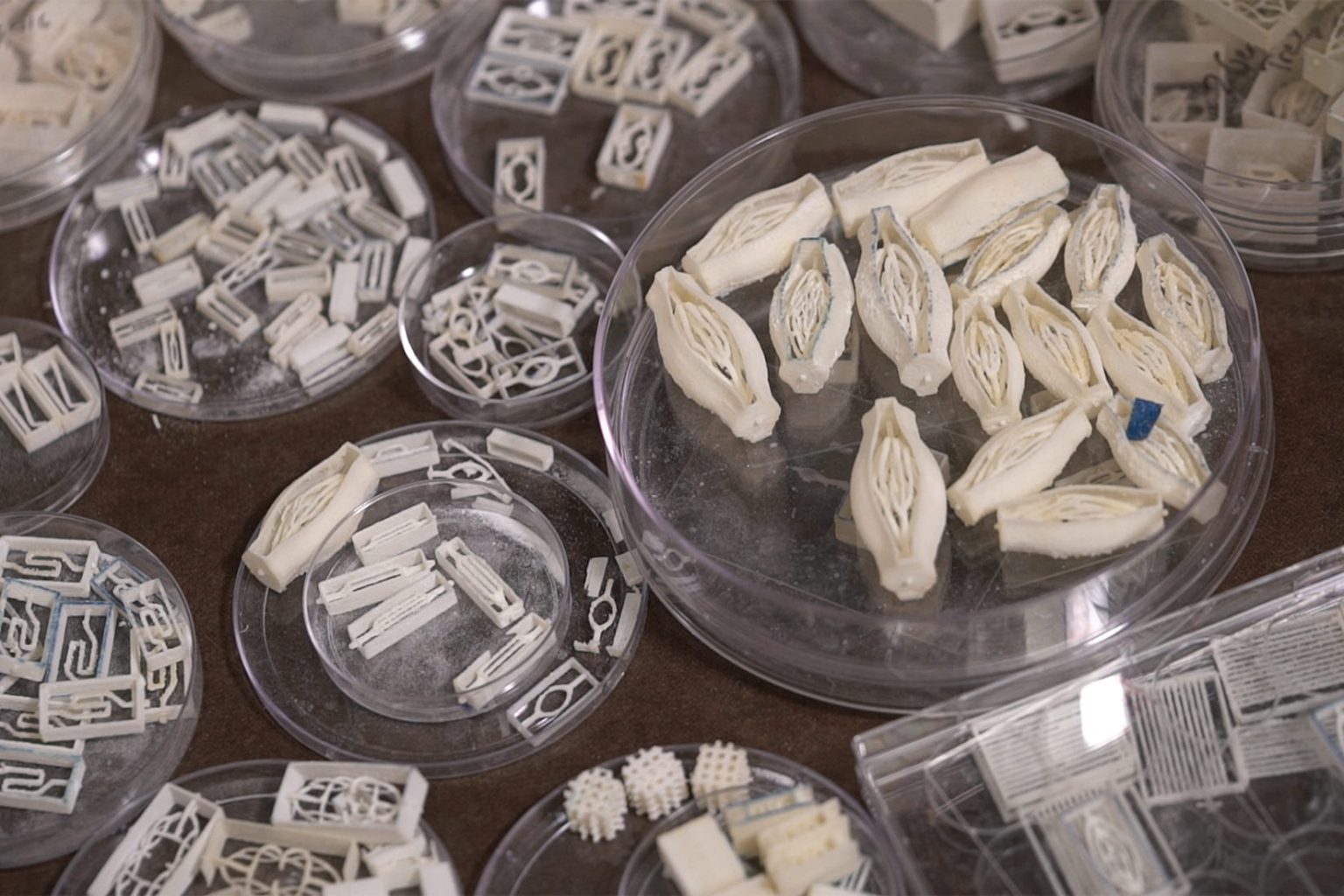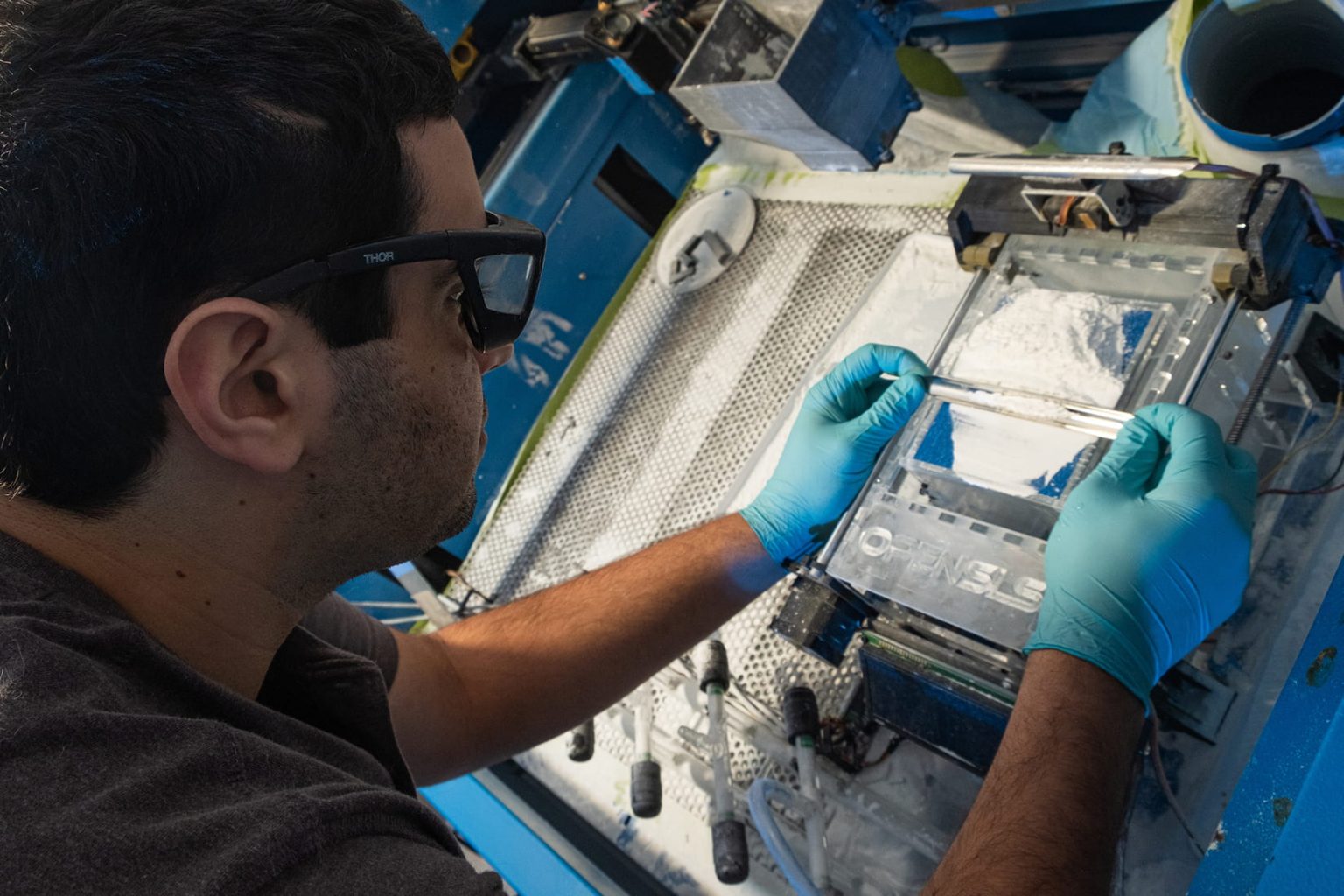
糖粉是莱斯大学食谱中的特殊成分,用于模仿人体在实验室生长的组织中复杂的分支血管。这种用于糖3D打印血管的方法并不完全新颖:糖已用于选择性激光烧结的实验和生物打印中。在发表在《自然生物医学工程》(Nature Biomedical Engineering)杂志上的研究中,赖斯(Rice)生物工程师表明,他们可以通过从3D打印糖的模板创建复杂的血管网络,在相对较大的结构中使密集包装的细胞存活两周。
Powdered sugar is the special ingredient in a Rice University recipe for mimicking the body’s intricate, branching blood vessels in lab-grown tissues. This approach to sugar 3D printed blood vessels is not entirely new: sugar has already been used in experiments with selective laser sintering and in bioprinting. In the research published in the journal Nature Biomedical Engineering, Rice bioengineers showed they could keep densely packed cells alive for two weeks in relatively large constructs by creating complex blood vessel networks from templates of 3D printed sugar.
赖斯布朗工程学院生物工程研究生Ian Kinstlinger说:“工程化与临床相关的组织的最大障碍之一是将一个大的组织结构包装成数以亿计的活细胞。” “在如此大量的组织中为所有细胞提供足够的氧气和营养成为一项巨大的挑战。”
“One of the biggest hurdles to engineering clinically relevant tissues is packing a large tissue structure with hundreds of millions of living cells,” said study lead author Ian Kinstlinger, a bioengineering graduate student in Rice’s Brown School of Engineering. “Delivering enough oxygen and nutrients to all the cells across that large volume of tissue becomes a monumental challenge.”
Kinstlinger解释说,大自然通过复杂的血管网络的发展解决了这个问题,该网络通过我们的组织和器官以类似于树枝的方式编织。随着血管从中央躯干分支出来,血管的厚度同时变小,但数量却增加,从而使氧气和营养物质有效地传递到整个身体的细胞。
Kinstlinger explains that nature solved this problem through the evolution of complex vascular networks, which weave through our tissues and organs in patterns reminiscent of tree limbs. The vessels simultaneously become smaller in thickness but greater in number as they branch away from a central trunk, allowing oxygen and nutrients to be efficiently delivered to cells throughout the body.

赖斯大学生物工程研究生伊恩·金斯特林格(Ian Kinstlinger)带有用糖粉3D打印的血管模板。 Kinstlinger是一项研究的主要合著者,该研究表明,用这种模板制成的实验室生长的组织具有足够的血流,可以维持密集包装的细胞。
Rice University bioengineering graduate student Ian Kinstlinger with a blood vessel template he 3D-printed from powdered sugar. Kinstlinger is lead co-author of a study that showed that lab-grown tissues made from such templates had sufficient blood flow to sustain densely packed cells. (Photo by Jeff Fitlow/Rice University)
“通过开发模仿自然存在的血管网络的新技术和新材料,我们越来越接近可以为足够数量的细胞提供氧气和营养以达到有意义的长期治疗作用的点,”金斯特林格说。
“By developing new technologies and materials to mimic naturally occurring vascular networks, we’re getting closer to the point that we can provide oxygen and nutrients to a sufficient number of cells to get meaningful long-term therapeutic function,” Kinstlinger said.
在研究的共同作者,赖斯生物工程助理教授约旦·米勒(Jordan Miller)的实验室中,用开放源代码,经过修改的激光切割机对糖模板进行了3D打印。 “我们在这里开发的3D打印过程就像制作非常精确的焦糖布丁,”米勒说,他对该项目的最初灵感是精致的甜点。
The sugar templates were 3D-printed with an open-source, modified laser cutter in the lab of study co-author Jordan Miller, an assistant professor of bioengineering at Rice. “The 3D-printing process we developed here is like making a very precise creme brulee,” said Miller, whose original inspiration for the project was an intricate dessert.
米勒说,复杂而细致的结构是通过选择性激光烧结实现的,选择性激光烧结是一种将细微的粉末颗粒融合成固体3D对象的3D打印过程。与更普通的挤出3D打印不同,在挤出3D打印中,熔化的材料束通过喷嘴沉积,而激光烧结则通过在干燥粉末填充床中轻轻熔化并融合小区域来进行工作。他说,挤压和激光烧结都可以一次形成一个2D层的3D形状,但是激光方法可以生成结构,否则结构如果被挤压就容易塌陷。
Miller said the complex, detailed structures are made possible by selective laser sintering, a 3D-printing process that fuses minute grains of powder into solid 3D objects. In contrast to more common extrusion 3D printing, where melted strands of material are deposited through a nozzle, laser sintering works by gently melting and fusing small regions in a packed bed of dry powder. Both extrusion and laser sintering build 3D shapes one 2D layer at a time, but the laser method enables the generation of structures that would otherwise be prone to collapse if extruded, he said.
米勒说:“有某些架构,例如悬垂结构,分支网络和多血管网络,这些在挤出印刷中确实无法很好地完成。”米勒在博士后研究中用3D挤出打印机演示了糖模板的概念。在宾夕法尼亚大学。米勒(Miller)在2013年加入莱斯(Rice)后不久就开始从事激光烧结方法的研究。
“There are certain architectures — such as overhanging structures, branched networks and multi vascular networks — which you really can’t do well with extrusion printing,” said Miller, who demonstrated the concept of sugar templating with a 3D extrusion printer during his postdoctoral studies at the University of Pennsylvania. Miller began work on the laser-sintering approach shortly after joining Rice in 2013.
糖在创建血管模板方面特别有用,因为它在干燥时会很持久,并且可以迅速溶于水而不会损坏附近的细胞。为了制作薄纸,Kinstlinger使用一种特殊的糖混合物来印刷模板,然后用液体凝胶中的细胞混合物填充印刷糖网络周围的体积。凝胶在数分钟内变成半固体,然后糖溶解并冲走,留下了养分和氧气的开放通道。
Sugar is especially useful in creating blood vessel templates because it’s durable when dry, and it rapidly dissolves in water without damaging nearby cells. To make tissues, Kinstlinger uses a special blend of sugars to print templates and then fills the volume around the printed sugar network with a mixture of cells in liquid gel. The gel becomes semisolid within minutes, and the sugar is then dissolved and flushed away to leave an open passageway for nutrients and oxygen.
Kinstlinger说:“这种方法的主要好处是我们可以快速生成每种组织结构。” “我们可以在不到五分钟的时间内创建一些迄今已展示的最大的组织模型。”
“A major benefit of this approach is the speed at which we can generate each tissue structure,” Kinstlinger said. “We can create some of the largest tissue models yet demonstrated, in under five minutes.”

赖斯大学生物工程师使用糖粉的特殊混合物3D打印的血管模板样本。
A sample of blood vessel templates that Rice University bioengineers 3D-printed using a special blend of powdered sugars. (Photo by B. Martin/Rice University)
米勒说,这项新研究回答了两个重要问题:哪些糖可以烧结成连贯的结构,什么计算算法可以衍生出模仿自然界中发现的复杂分支结构?
Miller said the new study answers two important questions: What sugars can be sintered into coherent structures, and what computational algorithms can derive complex, branching architectures that mimic those found in nature?
与研究系统Nervous System合作创建了在研究中生成树状血管结构的计算算法,该系统使用计算机模拟来制作受自然界图案启发的独特艺术品,珠宝和家居用品。
The computational algorithm that generated the treelike vascular architectures in the study was created in collaboration with Nervous System, a design studio that uses computer simulation to make unique art, jewelry and housewares that are inspired by patterns found in nature.
《神经系统》杂志的联合创始人兼创意总监,研究合著者杰西卡·罗森克兰茨(Jessica Rosenkrantz)说:“我们正在使用受自然启发的算法来创建组织的功能网络。” “由于我们的方法是算法化的,因此有可能创建针对不同用途的自定义网络。”
“We’re using algorithms inspired by nature to create functional networks for tissues,” said Jessica Rosenkrantz, co-founder and creative director of Nervous System and a study co-author. “Because our approach is algorithmic, it’s possible to create customized networks for different uses.”
在创建了以这些可计算生成的血管结构图案化的组织后,研究小组展示了通道内内皮细胞的播种,并致力于研究周围组织中生长的细胞(包括称为肝细胞的啮齿动物肝细胞)的存活和功能。肝细胞实验是与华盛顿大学(UW)生物工程师和研究合著者凯利·史蒂文斯(Kelly Stevens)合作进行的,凯利·史蒂文斯(Kelly Stevens)的研究小组专门研究脆弱的细胞,众所周知,这些细胞很难在体外维持。
After creating tissues patterned with these computationally generated vascular architectures, the team demonstrated the seeding of endothelial cells inside the channels and focused on studying the survival and function of cells grown in the surrounding tissue, including rodent liver cells called hepatocytes. The hepatocyte experiments were conducted in collaboration with University of Washington (UW) bioengineer and study co-author Kelly Stevens, whose research group specializes in studying the delicate cells, which are notoriously difficult to maintain outside the body.

研究生伊恩·金斯特林格(Ian Kinstlinger)在莱斯大学的米勒生物工程实验室准备了选择性激光烧结系统。 Kinstlinger使用该系统从糖粉中3D打印血管模板。该模板使生物工程师能够制造出实验室中生长的组织,该组织具有足够的血流来维持密集堆积的细胞。
Graduate student Ian Kinstlinger prepares the selective laser sintering system in the Miller bioengineering lab at Rice University. Kinstlinger uses the system to 3D-print blood vessel templates from powdered sugar. The templates allow bioengineers to make lab-grown tissues that have sufficient blood flow to sustain densely packed cells. (Photo by Jeff Fitlow/Rice University)
史蒂文斯说:“与许多其他生物打印技术相比,这种方法可以与更广泛的材料混合物一起使用。” “这使它具有了难以置信的通用性。”
“This method could be used with a much wider range of material cocktails than many other bioprinting technologies,” Stevens said. “This makes it incredibly versatile.”
Miller说:“我们证明了通过3D血管网络进行灌注使我们能够维持这些大型的肝样组织。尽管仍然存在与维持肝细胞功能有关的长期挑战,但是能够产生大量组织并在足够长的时间内维持这些体积的细胞以评估其功能的能力是向前迈出的令人振奋的一步。”
Miller said, “We showed that perfusion through 3D vascular networks allows us to sustain these large liverlike tissues. While there are still long-standing challenges associated with maintaining hepatocyte function, the ability to both generate large volumes of tissue and sustain the cells in those volumes for sufficient time to assess their function is an exciting step forward.”
史蒂文斯(Stevens)是威斯康星大学工程学院的生物工程学助理教授,威斯康星大学医学院的病理学助理教授以及威斯康星大学医学院干细胞与再生医学研究所的研究员。
Stevens is an assistant professor of bioengineering in the UW College of Engineering, assistant professor of pathology in the UW School of Medicine and an investigator at the UW Medicine Institute for Stem Cell and Regenerative Medicine.
其他作者包括赖斯的吉赛尔·卡尔德隆,凯伦·巴斯克斯·鲁伊斯,大卫·雅拉基,帕尔瓦沙·德梅,凯文·詹森,丹尼尔·萨泽尔和萨朗·潘恰瓦蒂。华盛顿大学的萨拉·萨克斯顿和弗雷德里克·约翰逊Jesse Louis-Rosenberg神经系统;和贝勒医学院的Karl-Dimiter Bissig。
Additional authors include Gisele Calderon, Karen Vasquez Ruiz, David Yalacki, Palvasha Deme, Kevin Janson, Daniel Sazer and Saarang Panchavati, all of Rice; Sarah Saxton and Fredrik Johansson, both of UW; Jesse Louis-Rosenberg of Nervous System; and Karl-Dimiter Bissig of Baylor College of Medicine.
这项工作得到了罗伯特·J·克莱伯格(Robert J. Kleberg)和海伦·克莱伯(Helen C. Kleberg)基金会,美国国立卫生研究院(HL134510,DK115461,DP2HL137188,T32EB001650,HL140905)和得克萨斯州癌症预防和研究所的支持,它们来自德克萨斯州肝细胞癌协会。
The work was supported by the Robert J. Kleberg Jr. and Helen C. Kleberg Foundation, the National Institutes of Health (HL134510, DK115461, DP2HL137188, T32EB001650, HL140905) and the Cancer Prevention and Research Institute of Texas via the Texas Hepatocellular Carcinoma Consortium (CPRIT RP150587).
文章来源:3dprintingmedia